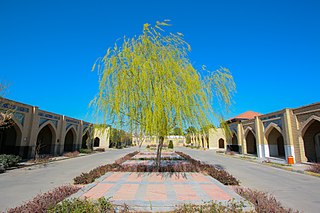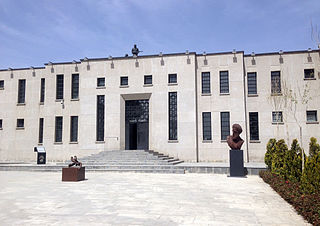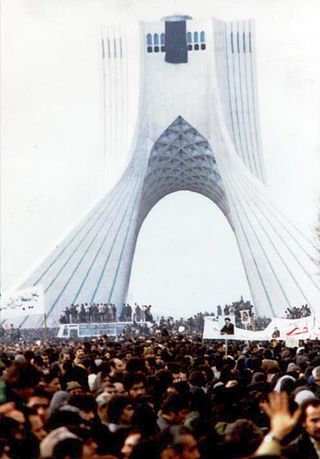
The Qajar dynasty was an Iranian royal dynasty founded by Mohammad Khan of the Qoyunlu clan of the Turkoman Qajar tribe.

The prime minister of Iran was a political post that had existed in Iran (Persia) during much of the 20th century. It began in 1906 during the Qajar dynasty and into the start of the Pahlavi dynasty in 1923 and into the 1979 Iranian Revolution before being abolished in 1989.

Behesht-e Zahra is the largest cemetery in Iran. Located in the southern part of metropolitan Tehran, it is connected to the city by Tehran Metro Line 1.

The history of the Iranian Air Force, currently known as the Islamic Republic of Iran Air Force, can be divided into two phases—before the Islamic Revolution, and after it.

Shahnaz Pahlavi is the first child of the former Shah of Iran, Mohammad Reza Pahlavi, and his first wife, Princess Fawzia of Egypt.

Mohammad Hosayn Âyrom was a senior military leader of the Pahlavi dynasty of Iran during the reign of king Reza Shah. He was the nephew of General Teymur Xân Âyromlu and a first cousin of Queen Tâj ol-Moluk Âyromlu. Only some members of the Ayrums family spelled their surname "Âyromlu" with the added suffix "-lu".

Amanollah Jahanbani was a member of the Qajar dynasty of Iran and a senior general of Reza Shah Pahlavi.

Lieutenant general Ahmad Amir-Ahmadi was an Iranian military leader and cabinet Minister of Iran.

The Museum of the Qasr Prison is a historical complex in Tehran, Iran.

This article is a timeline of events relevant to the Islamic Revolution in Iran. For earlier events refer to Pahlavi dynasty and for later ones refer to History of the Islamic Republic of Iran. This article doesn't include the reasons of the events and further information is available in Islamic revolution of Iran.

Mohammad Reza Pahlavi, commonly referred to in the Western world as Mohammad Reza Shah, or simply the Shah, was the last monarch of Iran (Persia). In 1941 he succeded his father Reza Shah and ruled the Imperial State of Iran until 1979 when the Iranian Revolution overthrew him, abolished the monarchy and established the Islamic Republic of Iran. In 1967, he took the title Shahanshah and also held several others, including Aryamehr and Bozorg Arteshtaran. He was the second and last ruling monarch of the Pahlavi dynasty. His vision of the "Great Civilization" led to his leadership over rapid industrial and military modernization, as well as economic and social reforms in Iran.

Arteshbod Abbas Karim Gharabaghi was an Iranian general who was the last chief of staff of the Iranian Armed Forces as well as deputy commander-in-chief of the Iranian Imperial Army under the rule of Mohammad Reza Pahlavi, the last Shah of Iran. Gharabaghi was one of two senior military officials who were not detained and executed by the Islamic Revolutionary Council. With Fardoost, he convinced the army to get a neutral position as he was linked with the Revolutionary and foreign intelligence forces.
The Physical Education Organization was an effort by the Government of Iran to promote the development of athletics and sporting activities of Iran. It was dissolved in late 2010 and its responsibilities transferred to the Ministry of Sport and Youth.

The Golden Crown was Iran's first national aerobatics display team and part of the former Imperial Iranian Air Force from 1958 to 1979. It was formed by Nader Jahanbani, an Iranian fighter pilot, and mainly inspired by the USAFE Skyblazers, an American aerobatics team. During the Cold War this team successfully performed in many competitions.

Fatemeh Pahlavi was the Iranian-born tenth child of Reza Shah Pahlavi, and half-sister of Mohammad Reza Pahlavi. She was a member of the Pahlavi dynasty.
Khosrow Jahanbani was the son of Iranian general Amanullah Jahanbani and second husband of Princess Shahnaz Pahlavi.

Arteshbod Mohammad Amir Khatami, CVO, was the commander of the Imperial Iranian Air Force, advisor to Shah Mohammad Reza Pahlavi and the second husband of Fatemeh Pahlavi, half-sister of the Shah.

Amir Hossein Rabii was an Iranian senior military officer who served as the commander in chief of Imperial Iranian Air Force from 1976 to 1979. He was the last commander of the force.
Fazael Tadayon was a full general at the Pahlavi Iran's air force and served as the chief of the staff of the Imperial Iranian Air Force. He was made the commander of the air force on 13 September 1975 replacing Mohammad Amir Khatami who died a day before in a kiting accident. Tadayon's tenure was brief and lasted until 1976 when he was killed in a helicopter accident. He was succeeded by Amir Hossein Rabii as the chief of Imperial Iranian Air Force.
















